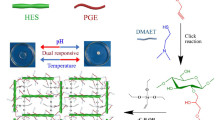Abstract
An original multicompartmental drug delivery system based on encapsulation of “intelligent” starch microspheres was designed and developed. Starch microspheres with thermo-responsive properties and possessing strong anionic functional groups (-SO3H), capable to bind electrostatically drugs, has been prepared. Firstly, the thermo-responsive units based on copolymer of poly(N-isopropylacrylamide-co-N,N-dimethylacrylamide) with a lower critical solution temperature around 36ºC, were grafted on preformed starch microspheres. Secondly, the strong anionic groups (-SO3H) were introduced by sequential grafting of 2-acrylamido-2-methyl-1-propanesulfonic acid on the remaining—OH groups of starch. The thermo-sensitive microspheres with sulfonic groups display a sharp phase transition around the human body temperature. They were complexed with the positively-charged metoclopramide (low molecular weight model drug) and then encapsulated in cellulose acetate butyrate microcapsules by an oil-in-water solvent evaporation method. The swelling and diffusion of encapsulated microspheres to the aqueous continuous phase is avoided because the temperature of aqueous phase is higher than volume phase transition temperature (VPTT) of microspheres. This multicompartmental device could develop the background of “smart” implantable drug delivery system for persons that work in dangerous cold places (builders, climbers). When the temperature of the human body decreases below the normal temperature (the threshold temperature could be tuned), the encapsulated microspheres swell extensively in contact with physiological fluids, break the microcapsules and a large amount of bioactive compounds is released, keeping the activity of the vital organs. In normal physiological conditions (above LCST), the microspheres slightly swell, fill up the microcavities of microcapsules, but do not break them and release the drug in microcompartments. These microcompartments become microreservoirs with bioactive compounds and release it with a very low rate maintaining the necessary concentration for a sustained activity of the body.







Similar content being viewed by others
Abbreviations
- AMPSA:
-
2-acrylamido-2-methyl-1-propanesulfonic acid
- APS:
-
ammonium persulfate
- CAB:
-
cellulose acetate butyrate
- CAN:
-
cerium (IV) ammonium nitrate
- CyH:
-
cyclohexane
- DMAAm:
-
N,N-dimethylacrylamide
- ECH:
-
epichlorohydrin
- LCST:
-
lower critical solution temperature
- NIPAAm:
-
N-isopropylacrylamide
- PB:
-
phosphate buffer
- PNIPAAm:
-
poly(N-isopropylacrylamide)
- PVA:
-
poly(vinyl alcohol)
- SBL:
-
soybean lecithin
- SEM:
-
scanning electron microscopy
- St:
-
starch
- TEMED:
-
N,N,N′,N′-tetramethylethylenediamine
- VPTT:
-
volume phase transition temperature
References
I. Ankareddi, C.S. Brazel, Int. J. Pharm. 336, 241 (2007). doi:10.1016/j.ijpharm.2006.11.065
Y. Cao, C. Zhang, W. Shen, Z. Cheng, L. Yu, Q. Ping, J. Control. Release 120, 186 (2007). doi:10.1016/j.jconrel.2007.05.009
J. Chen, M. Chu, K. Koulajian, X.Y. Wu, A. Giacca, Y. Sun, Biomed. Microdevices (2009) doi:10.1007/s10544-009-9344-2
M. Constantin, G. Fundueanu, F. Bortolotti, R. Cortesi, P. Ascenzi, E. Menegatti, Int. J. Pharm. 330, 129 (2007). doi:10.1016/j.ijpharm.2006.09.005
A. D’Emanuele, R. Dinarvand, Int. J. Pharm. 118, 237 (1995). doi:10.1016/0378-5173(94)00384-H
F. Eeckman, A.J. Moës, K. Amighi, Eur. Polym. J. 40, 873 (2004). doi:10.1016/j.eurpolymj.2003.11.010
H. Feil, Y.H. Bae, J. Feijen, S.W. Kim, Macromolecules 26, 2496 (1993). doi:10.1021/ma00062a016
G. Fundueanu, M. Constantin, A. Dalpiaz, F. Bortolotti, R. Cortesi, P. Ascenzi, E. Menegatti, Biomaterials 25, 159 (2004). doi:10.1016/S0142-9612(03)00477-0
G. Fundueanu, M. Constantin, F. Bortolotti, P. Ascenzi, R. Cortesi, E. Menegatti, Macromol. Biosci. 5, 955 (2005a). doi:10.1002/mabi.200500099
G. Fundueanu, M. Constantin, E. Esposito, R. Cortesi, C. Nastruzzi, E. Menegatti, Biomaterials 26, 4337 (2005b). doi:10.1016/j.biomaterials.2004.10.036
G. Fundueanu, M. Constantin, F. Bortolotti, R. Cortesi, P. Ascenzi, E. Menegatti, Eur. J. Pharm. Biopharm. 66, 11 (2007). doi:10.1016/j.ejpb.2006.09.002
G. Fundueanu, M. Constantin, P. Ascenzi, Biomaterials 29, 2767 (2008). doi:10.1016/j.biomaterials.2008.03.025
M. Heskins, J.E. Guillet, J. Macromol. Sci. Chem. A2, 1441 (1968)
A. Khan, J. Colloid. Interf. Sci. 313, 697 (2007). doi:10.1016/j.jcis.2007.05.027
B. Kim, N.A. Peppas, Biomed Microdevices 5, 333 (2003). doi:10.1023/A:1027313931273
W.-F. Lee, R.-J. Chiu, Mat. Sci. Eng. C 20, 161 (2002). doi:10.1016/S0928-4931(01)00476-3
E.S. Matsuo, T. Tanaka, J. Chem. Phys. 89, 1695 (1988). doi:10.1063/1.455115
C.L. Mc Cormick, L.S. Park, J. Polym. Sci.: Pol. Chem. 19, 2229 (1981). doi:10.1002/pol.1981.170190909
M.G. Moldenhauer, J.G. Nairn, J. Pharm. Sci. 79, 659 (1990). doi:10.1002/jps.2600790802
T.G. Park, A.S. Hoffman, J. Appl. Polym. Sci. 46, 659 (1992). doi:10.1002/app.1992.070460413
J.H. Priest, S.L. Murry, R.J. Nelson, A.S. Hoffman, ACS Symp. Ser. 350, 255 (1986)
M. Rodriquez, J.L. Vila-Jato, D. Torres, J. Control. Release 55, 67 (1998). doi:10.1016/S0168-3659(98)00029-7
Z.M.O. Rzaev, S. Dinçer, E. Pişkin, Prog. Polym. Sci. 32, 534 (2007). doi:10.1016/j.progpolymsci.2007.01.006
M. Sriwongjanya, R. Bodmeier, Int. J. Pharm. 158, 29 (1997). doi:10.1016/S0378-5173(97)00212-3
D. Torres, L. Boado, D. Blanco, J.L. Vila-Jato, Int. J. Pharm. 173, 171 (1998). doi:10.1016/S0378-5173(98)00224-5
J. Wang, Z. Chen, M. Mauk, K.-S. Hong, M. Li, S. Yang, H. Bau, Biomed. Microdevices 7, 313 (2005). doi:10.1007/s10544-005-6073-z
J. Zhang, R.D.K. Misra, Acta Biomater. 3, 838 (2007). doi:10.1016/j.actbio.2007.05.011
Acknowledgements
The authors are grateful to Dr. Loris Leboffe (Department of Biology, University “Roma Tre”, Rome, Italy) for helpful discussions. Thanks are also due to the group of Dynamic Mechanical Analysis Laboratory (“Petru Poni” Institute of Macromolecular Chemistry, Iasi, Romania) for performing the DMA studies. This study was supported by grant from Ministry of Education and Research of Romania (Consiliul National al Cercetarii Stiintifice din Invatamantul Superior, PCE “Idei”-2008, ID_989, Contract nr. 644/2009).
Author information
Authors and Affiliations
Corresponding author
Rights and permissions
About this article
Cite this article
Fundueanu, G., Constantin, M., Ascenzi, P. et al. An intelligent multicompartmental system based on thermo-sensitive starch microspheres for temperature-controlled release of drugs. Biomed Microdevices 12, 693–704 (2010). https://doi.org/10.1007/s10544-010-9422-5
Published:
Issue Date:
DOI: https://doi.org/10.1007/s10544-010-9422-5




